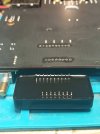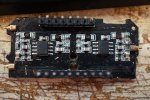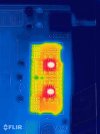No-one can answer that without the /missing info. Id suggest contacting susvara to ask them.how loud will pa5 drive the hifiman susvara, the actual sensitivity is 79 db/ unknown 1 vrms or not
-
WANTED: Happy members who like to discuss audio and other topics related to our interest. Desire to learn and share knowledge of science required. There are many reviews of audio hardware and expert members to help answer your questions. Click here to have your audio equipment measured for free!
- Forums
- Audio, Audio, Audio!
- Amplifiers, Phono preamp, and Analog Audio Review
- Stereo and Multichannel Amplifier Reviews
You are using an out of date browser. It may not display this or other websites correctly.
You should upgrade or use an alternative browser.
You should upgrade or use an alternative browser.
Topping PA5 Review (Amplifier)
- Thread starter amirm
- Start date
Why would you want to use a PA5 speaker amp for 60Ω/84dB headphones?how loud will pa5 drive the hifiman susvara, the actual sensitivity is 79 db/ unknown 1 vrms or not
The PA5 only provides ASR measurement results when connected to speakers.
In order to use PA5 with a headphone load, it is necessary to lower the volume greatly, and it will be used in the area where THD+N has deteriorated, so there is no advantage to using PA5. It is also unknown whether PA5 operates stably with a load impedance of 60Ω.
For headphones, I suggest using a dedicated headphone amplifier.
staticV3
Master Contributor
- Joined
- Aug 29, 2019
- Messages
- 8,022
- Likes
- 12,870
Here is the Susvara's sensitivity and efficiency as claimed by Hifiman and measured by 3rd parties:how loud will pa5 drive the hifiman susvara, the actual sensitivity is 79 db/ unknown 1 vrms or not

The PA5 can output at least 26Vrms into 60Ω.
That's 92dB + 20*log10(26) = 120.3dB SPL , which is very loud.
staticV3
Master Contributor
- Joined
- Aug 29, 2019
- Messages
- 8,022
- Likes
- 12,870
Do some Amps become unstable as you decrease the load?It is also unknown whether PA5 operates stably with a load impedance of 60Ω.
Why would you want to use a PA5 speaker amp for 60Ω/84dB headphones?
For headphones, I suggest using a dedicated headphone amplifier.
many even use la90 to drive those planars, anyway, forget about the headphones. can you take a look at the la90 power supply, 64v/4a, so this la90 can't be using tpa3250/51? what's your opinion about the chip inside?

Topping LA90 Review (Integrated Amplifier)
This is a review and detailed measurements of the Topping LA90 integrated amplifier. It was sent to me by the company and costs US $800. I must say, this is one interesting industrial design. Everything oozes style despite the diminutive package. This aspect continues in the operation of the...
 www.audiosciencereview.com
www.audiosciencereview.com
juliangst
Addicted to Fun and Learning
Most headphone amps just don't have enough power for certain planars. My Topping A30 Pro struggles a lot with my Aeon Noire and Susvaras need even more juiceWhy would you want to use a PA5 speaker amp for 60Ω/84dB headphones?
You also need to know your distance from the speakers, and distance from speakers to nearby reflecting surfaces. Here is an online estimator: http://myhometheater.homestead.com/splcalculator.html Note the SPL chart lower on the page; 80 dB average is very loud to me, so I am quite content with being able to produce 100 dB SPL peaks at the listening position (20 dB headroom over louder than I am likely to listen).how loud will pa5 drive the hifiman susvara, the actual sensitivity is 79 db/ unknown 1 vrms or not
HTH - Don
juliangst
Addicted to Fun and Learning
Probably 1cm because it's a HEADPHONEYou also need to know your distance from the speakers, and distance from speakers to nearby reflecting surfaces. Here is an online estimator: http://myhometheater.homestead.com/splcalculator.html Note the SPL chart lower on the page; 80 dB average is very loud to me, so I am quite content with being able to produce 100 dB SPL peaks at the listening position (20 dB headroom over louder than I am likely to listen).
HTH - Don
Oops... I did not read far enough, nor look up what a "hifiman susvara" is, duh. I also seem to have skipped the last page of the thread, the Wonders of Chrome. What I get for posting in the middle of running tests at 6 am (and I've been here a while already, long week). I don't drink coffee but maybe I should...
Thanks and sorry guys, hope I gave you a laugh - Don
Thanks and sorry guys, hope I gave you a laugh - Don
juliangst
Addicted to Fun and Learning
No problem. Susvara is a 6000 € planar headphone that's so inefficient that most people just use speaker amps to power themOops... I did not read far enough, nor look up what a "hifiman susvara" is, duh. I also seem to have skipped the last page of the thread, the Wonders of Chrome. What I get for posting in the middle of running tests at 6 am (and I've been here a while already, long week). I don't drink coffee but maybe I should...
Thanks and sorry guys, hope I gave you a laugh - Don
Why would you want to use a PA5 speaker amp for 60Ω/84dB headphones?
btw, you mean it's quite loud from the mobo output?
Hi Daniboun, could you list this exact DC filter used in PSU, and may be other components for whole assembly, please?Hi Amigos,
Just finished to mount the New Active PFC PSU A-DP 400. By testing it I made a great discovery, in any case it is observable at home!
I first set the A-DP 400 @ 40V / 10A, The PA5 simply refused to switch on, like it was going into protected mode
Then I gradually lowered the voltage, and @ 36V it starts ) This makes me say that the PA5 has a protection tuned by topping to avoid tweaking its nominal voltage.... I reproduced the scenario several times and I can therefore confirm this test with a multimeter measurement.
Now concerning the sound, I'm in the test phase and I'm going to listen to it with my Playlist at different volume levels, to see which of the two PSUs sounds better. As reminder :
Connex SMPS 300RS LLC @ 36V / 8,3A VS A-DP 400 Active PFC @ 36V / 11A
The Connex SMPS300RS use state of the art, very efficient LLC Series Resonant Converter Topology. Due to the soft-switched topology used, the SMPS300RS has very low EMI noise and also has a very low ripple.
The A-DP 400 has an active PFC controller for an high efficiency, PF value greater than 0.98, and its Output ripple is less than 150mV.
I mounted both PSUs with a DC blocker and good quality cables.




I live in a duplex where I rarely listen to speakers. I probably listen at moderate levels (5 watt max) maybe 3 hours a week at most.. are the issues mainly for people that put in 10+ hours a day at loud 20+ watt levels? Or is it just a lottery that 4 out of 10 of them have issues?
Note: I'd have the volume of the PA5 at max, but use a preamp plugged into it would be 5 watt max.
Note: I'd have the volume of the PA5 at max, but use a preamp plugged into it would be 5 watt max.
anli
Member
- Joined
- Oct 20, 2021
- Messages
- 82
- Likes
- 23
Vast majority of happy owners don't bother to vote.4 out of 10 of them have issues
The product has a fault that apparently occurs with regularity.I live in a duplex where I rarely listen to speakers. I probably listen at moderate levels (5 watt max) maybe 3 hours a week at most.. are the issues mainly for people that put in 10+ hours a day at loud 20+ watt levels? Or is it just a lottery that 4 out of 10 of them have issues?
Note: I'd have the volume of the PA5 at max, but use a preamp plugged into it would be 5 watt max.
anli
Member
- Joined
- Oct 20, 2021
- Messages
- 82
- Likes
- 23
Have you got some information to estimate statistics? "Regularity" means nothing. All products faults have got some regularity.regularity
Oh come on... Anybody that's been around here regularly for several months or more knows what has occurred. Topping messed up some product somehow and they shipped it to customers for warranty processing.Have you got some information to estimate statistics? "Regularity" means nothing. All products faults have got some regularity.
Pay your money and take your chances. You have been warned.
gamerpaddy
Member
So, after this https://www.audiosciencereview.com/...owners-only-please.33293/page-48#post-1350183
i took apart my pa5 and depotted that mystery module (it got pretty hot). didnt took as long as i expected. some heat gunning and careful prying and cleaning afterwards.


So lets depot it, i got some experience in this from my last project
 www.diyaudio.com
www.diyaudio.com


Its a 4 layer PCB...
even ripped off a ressitor as a bonus (which is weird since i didnt put a lot of force and my temp was below 260C. i think it had bad soldering from the factory. one of the possible failure points.)
it consist of
2 NE5532 (outputs are going (via resistors) to the output pins.)

and
2 OPA1612A (at the input)

The RC network on each side (top) has the PFFB lines going in and goes to the output pins directly
its literally this.. i didnt found a place where the legs of R3 went other than the reisistors nearby. no connection to the rest of the circuit.

those golden pogo pins are not connected to ground! neither the case has been its anodizing scraped off, its just a snap in retainer (theres small dents in the case) so the potting compoung can flow beneath.
So i put it all back together, obviously without the shielding to see if something is getting hot.
it works again... both channels at the same volume level. weird.
maybe micro degradation of one of those opamps, ne5532 is very reliable, not sure of that opa1612 tho.
or cracked solder joints due to the potting compound contracting/expanding over time.

i should have used jumper wires instead, so i can take a thermal photo of the underside.

its running great again, sounds like before even without the metal can. lets see how long.
i took apart my pa5 and depotted that mystery module (it got pretty hot). didnt took as long as i expected. some heat gunning and careful prying and cleaning afterwards.


So lets depot it, i got some experience in this from my last project
Metaxas CP-1 - Impossible repair? Crackling & Popping on one channel.
Hello, i got my hands on a CP-1 from MAS Metaxas. never heard of it? me neither, its so rare, you wont even find it on the internet, except in 2 (now 4..5) places. seems to be from the 80s, probably 86.. 87 or so. in their "how it all began story" pdf mentioned on page 7...


Its a 4 layer PCB...
even ripped off a ressitor as a bonus (which is weird since i didnt put a lot of force and my temp was below 260C. i think it had bad soldering from the factory. one of the possible failure points.)
it consist of
2 NE5532 (outputs are going (via resistors) to the output pins.)

and
2 OPA1612A (at the input)

The RC network on each side (top) has the PFFB lines going in and goes to the output pins directly
its literally this.. i didnt found a place where the legs of R3 went other than the reisistors nearby. no connection to the rest of the circuit.

those golden pogo pins are not connected to ground! neither the case has been its anodizing scraped off, its just a snap in retainer (theres small dents in the case) so the potting compoung can flow beneath.
So i put it all back together, obviously without the shielding to see if something is getting hot.
it works again... both channels at the same volume level. weird.
maybe micro degradation of one of those opamps, ne5532 is very reliable, not sure of that opa1612 tho.
or cracked solder joints due to the potting compound contracting/expanding over time.

i should have used jumper wires instead, so i can take a thermal photo of the underside.

its running great again, sounds like before even without the metal can. lets see how long.
Last edited:
Similar threads
- Replies
- 59
- Views
- 8K
- Poll
- Replies
- 891
- Views
- 181K
- Replies
- 15
- Views
- 970
- Replies
- 25
- Views
- 5K
- Replies
- 1K
- Views
- 177K
